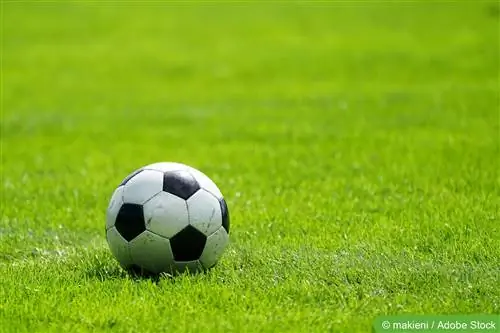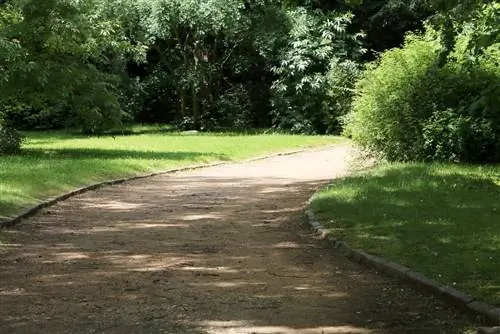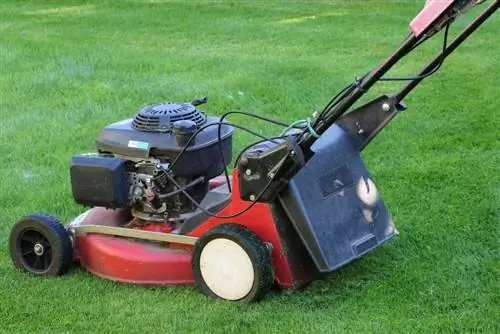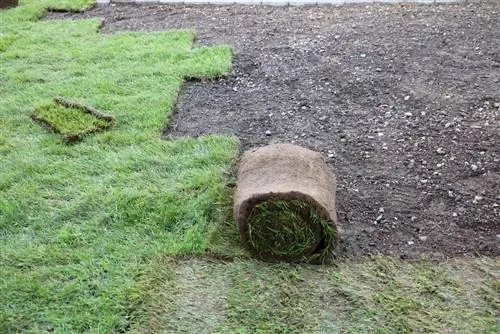- Author admin [email protected].
- Public 2023-12-17 03:39.
- Last modified 2025-06-01 06:48.
If children often play in the garden and on the lawn, then a sports lawn is also ideal in a private garden. Especially in such cases, the lawn must be able to withstand very high loads. In contrast to an ornamental lawn, the appearance should be placed in the background here. This is because the sports turf consists of types of grass that have robust foliage that can regenerate more quickly. There are seed mixtures for creating the optimal lawn with high resilience.
Ideal seed mixtures
If a sports turf is to be created, then the perfect seeds must also be chosen. In contrast to an ornamental or English lawn, a sports turf, for example on a playing field, has to withstand a lot more. Therefore, when planting, the hobby gardener primarily needs seeds for grass species that have coarse leaves and robust foliage. The ideal seed mixture for a sports turf therefore normally contains:
- three different sub-varieties of meadow bluegrass, Poa pratensis
- about 60% of this seed should be added to the mixture
- the remaining 40% consists of 2 different sub-varieties of the German ryegrass, Lolium perenne
If the lawn is planted in a very shady location, parts of bluegrass, Poa supina, can also be mixed into the mixture. If the soil on which the sports turf is being laid is particularly moist, parts of the grass type tall fescue, Festuca arundinacea, are added. This gives the gardener the perfect mixture for the sports turf.
Tip:
Before sowing, make sure that the seeds have been mixed well so that the lawn later grows in a he althy mixing ratio.
Tools required
If a lawn is newly laid on a selected area, it must be prepared. For this, the hobby gardener needs various tools that he should prepare before starting work.
- Spade
- if you have a particularly large area, use a rented excavator or tiller
- Rake
-
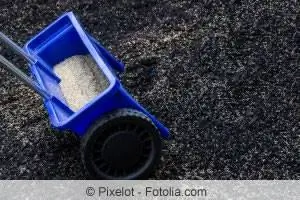
There are special sports turf mixtures for sowing for sports turf Water hose
- String and wooden sticks to mark out the area
- Sand and fertilizer, for example compost, to mix in
Preparation
Before the seed mixture can be sown, the soil must be prepared. Lawn, no matter what variety it belongs to, likes well-drained and slightly acidic soil. This soil quality should therefore already be present when sowing. Therefore, prepare as follows:
- Dig the ground with a spade or a large area with an excavator
- mix in sand and fertilizer at the same time, if it is compost
- for sand, expect up to 30 kg per square meter, depending on the soil condition
- If long-term fertilizer, such as blue grain, is used, it is distributed evenly over the area after digging
- if the soil is very damp or wet, create a drainage system
- mix larger pebbles into the soil
- If necessary, smooth out the prepared soil with a rake
- after the soil has been worked, allow about 14 days for it to settle
Tip:
Before sowing the lawn, you should consider whether to place electric lights around the lawn. The electrical cables can be laid with the system, which should be at least 40 - 50 cm deep in the ground. The same applies, of course, to an irrigation system.
Sowing
The best time to sow the lawn is spring just before or autumn just after summer. Then there is no possibility of frost and the sun is not too hot to harm the seeds. A windless and dry day is also ideal for laying the sports turf. When sown in windy conditions, the lawn seeds may even spread where they don't belong, such as in a flower bed. When sowing, pay attention to the following:
- Use fresh seeds, because the seeds lose their ability to germinate over time
- distribute the seeds evenly over the entire area
- Approximately 20 - 40 g of seeds are required per square meter
-
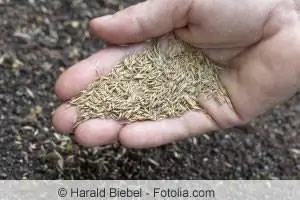
Sports turf for large areas should be sown with a spreader after sowing, carefully work the seeds into the soil with a rake
- Do not work deeper than 1 cm, otherwise the seeds will not germinate
- However, if lawn seeds are not incorporated, birds or ants will be happy
- If necessary, press the surface with a shovel or a hand roller
Tip:
If you don't trust yourself to be able to distribute the seeds evenly by hand, you can also borrow a spreader or a seed drill from the garden center.
Care tips
If the sports turf has been sown, it also needs to be maintained. This care takes some time so that the lawn grows thick and strong after sowing:
- Do not enter the area after sowing until a solid turf surface appears
- if possible, keep pets from entering
- The area must not dry out for the first six weeks, so water when there is no rain
- As soon as the sports turf has reached a height of around 12 cm, it can be cut for the first time
- Do not set the lawnmower too low, at least 6 cm should remain
The further care of the sports turf should not be neglected, because this type of lawn, like ornamental lawns, also needs a little attention from the hobby gardener. Because of the high level of stress that this lawn is exposed to, for example because children play on it every day, if it is not cared for enough it can quickly become a wasteland on which hardly a blade can grow. Therefore, the following should also be taken into account when caring for the sports turf:
- scarify in spring and autumn
- mowing regularly, once a week in summer
- water in the early morning or late evening when there is no rain in hot summers
- touch up bald or yellow spots directly
- To do this, loosen the soil and sow new seeds
- secure the area so that children playing do not step on it
- also remove matted areas in the lawn immediately and reseed
- If weeds on sports turf don't bother you, just mow over them
Tip:
In order to save having to scarify with an appropriate device, you can also use a lawnmower with a directly built-in scarifier.
Conclusion of the editors
If the ideal seed mixture is chosen in advance, the hobby gardener will receive a robust sports turf that doesn't mind if children run around and play here every day. But this lawn also needs a little care so that it remains attractive despite everything. Areas that have turned yellow must be replaced, and the lawn must also be watered regularly if it doesn't rain for a long time. One cut per week in summer is also usually a must so that the grass doesn't get too long and suffer from the many steps.
What you should know about sports turf in brief
- Sports turf is less suitable for the garden, but, as the name suggests, for sports facilities, sports fields and football stadiums.
- This type of lawn is very robust and wear-resistant. Weeds would be very inappropriate for football stadiums - therefore the lawn is not susceptible to weeds.
- It is characterized above all by its resilience. No other lawn is permanently exposed to such high stress.
- Sports turf can withstand these loads and also looks very good; The dark leafy green gives the sports field that certain something.
- When purchasing, you should make sure that the seeds are of high quality (branded seeds), otherwise too few seeds will germinate.
A high-performance sports turf mixture essentially consists of two types of grass: Lolium perenne is called perennial ryegrass in our language, it is a very durable grass that regenerates quickly and completely after damage. On the other hand, its appearance is somewhat robust, with coarse but strong stalks. In order to correct this somewhat more rustic appearance and also to make the sports turf denser, meadow panicle, botanically Poa pratensis, is added. It develops a rather fine image and impresses with its exceptionally dense growth, but the meadow panicle is still extremely resilient. There are many different varieties of both grasses that can be added to a seed mixture, and each type grows particularly well in certain places, which is why several varieties of these grasses should always be used in a sports turf mixture.
You can buy such a sports turf mixture ready-made, as a so-called standard seed mixture. The mixture for new sports turf has the number 3.1 and is also called “Type of new sports turf”, it consists of Lolium perenne and Poa pratensis each in different varieties.
Regeneration of sports turf
- If the sports turf has been thoroughly damaged by many extreme games, it needs regeneration with reseeding.
- The use of a higher proportion of ryegrass has proven particularly useful for this reseeding.
- The reseeding lawn, RSM type 3.2, sports turf regeneration, consists of 85% Lolium perenne and 15% Poa pratensis in different varieties.
- You can also just get Lolium perenne (please in several varieties) and resow it, that should work too.
Sports turf as garden lawn
When it is said that sports turf is not suitable for the garden, reference is being made to the rather rustic appearance of such a turf. But perhaps you just like this look and can't do anything with fine English lawn, then you can of course also sow the sports turf mixture in your garden. For example, it is very conceivable that a somewhat coarse-looking sports lawn would look great in a cottage garden, with emphasis on a rustic effect.

